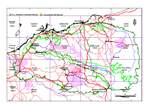Click on images
to enlarge



Photographer: B.R. Maslin
, Tropic of Capricorn, BRM 3 July 2003,_sml.jpg)
Photographer: B.R. Maslin

Spiny stipules. Photographer: E. Thoma

Photographer: B.R. Maslin

Photographer: B.R. Maslin
, BRM 2771, lab photo by Fiona McCallum ADJUSTED_sml.jpg)
Seed from one herbarium voucher. Scale in mm. Photographer: F. McCallum.
Botanical name
Acacia cuspidifolia Maslin, Nuytsia 4: 79, figs 4 & 10 (1982)
Common name
Bohemia (preferred common name) and Wait-a-while
Description
Large bushy, much-branched shrubs (3-6 m across) maturing to ±gnarled, robust trees 3-7 m high (and up to 9 m across). Bark dark grey, fibrous and longitudinally fissured on main trunks. Branchlets ±glabrous. New shoots bright light green. Stipules spiny, absent from some nodes, stout, spreading and shallowly recurved, 2-5 mm long. Phyllodes mostly narrowly oblong-oblanceolate to linear, narrowed at base, size rather variable, (2-) 3-6 (-7.5) cm long, 2-5 mm wide, straight to slightly curved, ±glabrous, olive green or occasionally dull sub-glaucous; midrib prominent; lateral nerves obscure when fresh (but becoming apparent when dry); ±abruptly contracted at apex into a fine yet sharply pungent point to about 2 mm long. Inflorescences simple and normally in pairs, initiated within axils of young phyllodes on actively growing new shoots, the subtending phyllodes reach maturity by the time the heads reach anthesis; peduncles 15-20 mm long, glabrous or sometimes hairy; heads delicately sweet-scented, globular, pale yellow to cream-coloured, 23-32-flowered. Flowers 5-merous; sepals free to ½ united. Pods narrowly oblong, flat, 4.5-9 cm long, 10-20 mm wide, papery, finely transversely reticulate, glabrous, light brown. Seeds transverse to oblique in pods, widely ellipsoid to widely ovoid, 6-7.5 mm long, dull, brown; held tightly in the pods by a strap-like funicle that is not expanded into an aril.
Characteristic features
Gnarled small trees. Stipules spiny, stout and shallowly recurved. Phyllodes narrowed towards the base, ±abruptly contracted at apex into a fine sharp point. Inflorescences simple (not racemose), in pairs within axil of phyllodes; heads pale yellow. Pods flat and papery, 10-20 mm wide. Seeds with a strap-like funicle that is not expanded into an aril.
Distribution and ecology
This species has a somewhat restricted natural distribution in northwest Western Australia but it is often quite common in the places where it occurs. Its main area of occurrence is in the Carnarvon, Gascoyne and Ashburton districts south of the Pilbara where it extends from the vicinity of Shark Bay north to Minilya Station (north of Carnarvon) and east to Mundiwindi (southeast of Newman) and near Meekatharra. The species appears to be rare in the Pilbara, being known only from near Paraburdoo (especially on Mininer Station) where it grows in clay soil on a broad floodplain. Over its geographic range A. cuspidifolia favours open floodplain and drainage line communities in alkaline clay or loam or on texture contrast soils (pH 7.5-9.5); the soils are typically shallow and may contain moderately high levels of soluble salts (Thomson and Hall 1989). In some areas outside the Pilbara this species also occurs in gilgai on stony uplands (Mitchell and Wilcox 1994).
Flowering and fruiting period
Flowering is mainly from October to December but flowers may occur at other times. Pods mature about 4 months after flowering and have been collected over a long period from January to July (Thomson and Hall 1989).
Affinities
Acacia cuspidifolia is a member of the 'A. victoriae group' (see Maslin 1992 for discussion) but is not likely to be confused with any of its relatives on account of its sharply spiny phyllode tips and by the combination of its non-racemose inflorescences of pale yellow flower heads. Other members of the 'A. victoriae group' which occur in the Pilbara include A. aphanoclada , A. cuspidifolia, A. glaucocaesia , A. robeorum , A. synchronicia and A. victoriae.
Notes
On account of its bushy, spreading habit A. cuspidifolia offers potential for shelter and soil protection plantings on saline, alkaline and stony soils in arid environments (however, sheep may become trapped by the spines that characterize this species).
The foliage persists during droughts and is eaten (especially by cattle) in periods of feed shortage, after which the plants make strong regrowth. The crude protein content varies from 9.5-11% and digestibility from 26-33%. When edible shrub populations growing with this species are suppressed by overgrazing, populations of A. cuspidifolia increase.
The wood is dense, making it satisfactory as a fuel, however, the crooked stems and prickly nature of the plants hamper collection.
The above information is derived from Thomson and Hall (1989) and Mitchell and Wilcox (1988).
Conservation status
Although this species is rare in the Pilbara it is common in more southerly districts and is therefore not considered rare or endangered.
Origin of name
The botanical name is derived from the Latin cuspidatus (pointed) and folium (leaf) in allusion to the characteristically sharply pointed phyllodes.
References
Maslin, B.R. (1992). Acacia Miscellany 6. A review of Acacia victoriae and related species (Leguminosae: Mimosoideae: Section Phyllodineae). Nuytsia 8: 285-309.
Mitchell, A.A. and Wilcox, D.G. (1988). Arid shrubland plants of Western Australia. pp. 478. (University of Western Australia in association with the Department of Agriculture Western Australia: Perth.)
Mitchell, A.A. and Wilcox, D.G. (1994). Arid shrubland plants of Western Australia. Edn. 2. pp. 478. (University of Western Australia Press in association with the Department of Agriculture: Perth.)
Thomson, L.A.J. and Hall, N. (1989). Acacia cuspidifolia. Australian Acacias, Leaflet No. 20. (CSIRO Division of Forests and Forest Products: Canberra.)
